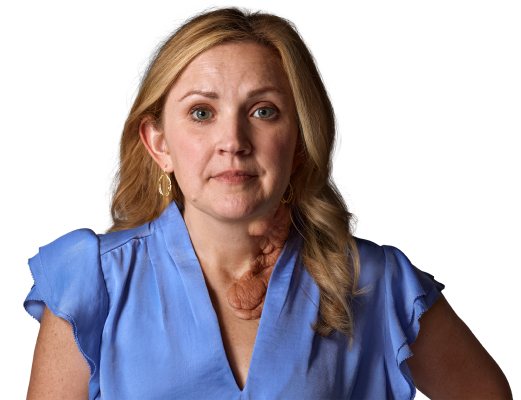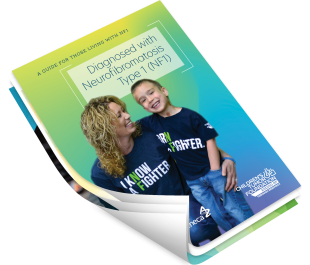This site is intended for US audiences only

NF1-PN can impact your life in many ways

NF1-PN has presented some challenges, especially as I’ve gotten older.
– Krista, living with NF1-PN
What people don't know about NF1-PN
The physical impact of NF1-PN
The tumors associated with NF1 are known as plexiform neurofibromas (PNs). Because the size, number, and location of tumors vary, they can affect the body in different ways. Common symptoms that people with NF1-PN experience include1-3:
Pain on and around the tumor
While sensation and severity vary, many people living with NF1-PN report pain when their tumor is touched.
Difficulty moving around
If a joint or limb is impacted, NF1-PN can cause issues with how you walk.
Changes in appearance
Since tumors are most often found on the head, neck, and face, they can cause noticeable changes to how you look.
If you have pain, you are not alone
The effects of NF1-PN can be serious
NF1-PN can be unpredictable
Owning your care
See Antwan talk about how he stays motivated even on tough days.
As far as what does owning your own care mean to me is one, knowing your body, knowing when something’s wrong, knowing when something’s off, and being able to communicate that to your doctors.
Like definitely when you live life with, with NF, you never know when something debilitating can happen to your body.
Really knowing when something’s off and having the discipline to contact your doctor and let them know.
And not like just thinking, like, well, I’m being a baby. It’s not that big of a deal.
Even if it’s small, it can turn into a big deal.
So when a doctor appointment is scheduled, you know, go to it.
Even if you think nothing’s wrong with you, you know, make sure you go to your follow up appointments.
I just love life too much not to take care of me. Cause you are your best asset. You are your best asset. Nobody can take better care of yourself than you.
Want more stories? Stay connected to hear from other people living with NF1-PN. Sign up now.
Mental and emotional impact of NF1-PN
People who don’t have NF1-PN, including family, friends, strangers, and even your doctor, may not realize the toll it can take on your mental and emotional health.
NF1, a downloadable resource that explains all the different ways the condition can impact your life.†
Memory and ability to focus
NF1 can hurt your memory. Having less ability to remember things or focus can make school or work challenging.12,13
“Although I spent a lot of time studying, I did not learn anything. I am still the same way. I go through some material over and over again, but after a few minutes I totally forget it. I can’t remember anything.”
– Real person living with NF113
Anxiety and depression
53.7%
HAD ANXIETY
76.8%
HAD DEPRESSION
How you socialize
Learn more about NF1 signs and symptoms
Staying engaged in your care
Having NF1-PN changes things. Taking an active role in your health can help you stay in control of what you can.
*
Based on a questionnaire completed by the caregivers of 59 NF1-PN patients, 6 to 18 years of age, and 41 NF1-PN patients, 10 to 18 years of age, who were enrolled in an NF1 natural history study at the National Cancer Institute.4
SpringWorks Therapeutics is providing these websites and resources to help patients find more information about NF1-PN, but their inclusion does not represent an endorsement or a recommendation from SpringWorks Therapeutics for any group or organization. Any organization listed is independent of SpringWorks Therapeutics.
- Darrigo LG Jr, Ferraz VEF, Cormedi MCV, et al. Epidemiological profile and clinical characteristics of 491 Brazilian patients with neurofibromatosis type 1. Brain Behav. 2022;12(6):e2599.
- Lai J-S, Jensen SE, Patel ZS, Listernick R, Charrow J. Using a qualitative approach to conceptualize concerns of patients with neurofibromatosis type 1 associated plexiform neurofibromas (pNF) across the lifespan. Am J Med Genet A. 2017;173(1):79-87.
- Wise JB, Cryer JE, Belasco JB, Jacobs I, Elden L. Management of head and neck plexiform neurofibromas in pediatric patients with neurofibromatosis type 1. Arch Otolaryngol Head Neck Surg. 2005;131(8):712-718.
- Wolters PL, Burns KM, Martin S, et al. Pain interference in youth with neurofibromatosis type 1 and plexiform neurofibromas and relation to disease severity, social-emotional functioning, and quality of life. Am J Med Genet A. 2015;167A(9):2103-2113.
- Rance G, Zanin J, Maier A, et al. Auditory dysfunction among individuals with neurofibromatosis type 1. JAMA Netw Open. 2021;4(12):e2136842.
- Gross AM, Singh G, Akshintala S, et al. Association of plexiform neurofibroma volume changes and development of clinical morbidities in neurofibromatosis 1. Neuro Oncol. 2018;20(12):1643-1651.
- Higham CS, Dombi E, Rogiers A, et al. The characteristics of 76 atypical neurofibromas as precursors to neurofibromatosis 1 associated malignant peripheral nerve sheath tumors. Neuro Oncol. 2018;20(6):818-825.
- Miettinen MM, Antonescu CR, Fletcher CDM, et al. Histopathologic evaluation of atypical neurofibromatous tumors and their transformation into malignant peripheral nerve sheath tumor in patients with neurofibromatosis 1—a consensus overview. Hum Pathol. 2017;67:1-10.
- Ferner RE, Huson SM, Thomas N, et al. Guidelines for the diagnosis and management of individuals with neurofibromatosis 1. J Med Genet. 2007;44(2):81-88.
- Stewart DR, Korf BR, Nathanson KL, Stevenson DA, Yohay K. Care of adults with neurofibromatosis type 1: a clinical practice resource of the American College of Medical Genetics and Genomics (ACMG). Genet Med. 2018;20(7):671-682.
- Fisher MJ, Blakeley JO, Weiss BD, et al. Management of neurofibromatosis type 1-associated plexiform neurofibromas. Neuro Oncol. 2022;24(11):1827-1844.
- Crow AJD, Janssen JM, Marshall C, et al. A systematic review and meta-analysis of intellectual, neuropsychological, and psychoeducational functioning in neurofibromatosis type 1. Am J Med Genet A. 2022;188(8):2277-2292.
- Foji S, Mohammadi E, Sanagoo A, Jouybari L. How do people with neurofibromatosis type 1 (the forgotten victims) live? a grounded theory study. Health Expect. 2022;25(2):659-666.
- Houpt AC, Schwartz SE, Coover RA. Assessing psychiatric comorbidity and pharmacologic treatment patterns among patients with neurofibromatosis type 1. Cureus. 2021;13(12):e20244.
- Rosnau K, Hashmi SS, Northrup H, Slopis J, Noblin S, Ashfaq M. Knowledge and self-esteem of individuals with neurofibromatosis type 1 (NF1). J Genet Couns. 2017;26(3):620-627.
- Legius E, Messiaen L, Wolkenstein P, et al. Revised diagnostic criteria for neurofibromatosis type 1 and Legius syndrome: an international consensus recommendation. Genet Med. 2021;23(8):1506-1513.
- Miller DT, Freedenberg D, Schorry E, Ullrich NJ, Viskochil D, Korf BR; Council on Genetics; American College of Medical Genetics and Genomics. Health supervision for children with neurofibromatosis type 1. Pediatrics. 2019;143(5):e20190660.
